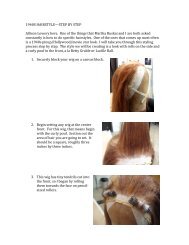Suite 8 - Focal Press: Book companions
Suite 8 - Focal Press: Book companions
Suite 8 - Focal Press: Book companions
You also want an ePaper? Increase the reach of your titles
YUMPU automatically turns print PDFs into web optimized ePapers that Google loves.
Figure 1.6 Collision<br />
Resonator 1 tab.<br />
<strong>Suite</strong> 8<br />
The Excitator tab handles the parameters for the Mallet and Noise (oscillators)<br />
sections, which determines the characteristic of the initial attack of the instrument,<br />
creating a physical model of the mallet. Note that the Noise section also<br />
generates white noise as part of its characteristic. You can use either excitator or<br />
both excitators as the initial attack sound source to be fed into the resonator(s),<br />
resulting in Collision’s characteristic sound.<br />
The Resonator tabs handle the parameters of each resonator and determine what<br />
object is used as the physical model (the strike surface) for the instrument’s<br />
timbral characteristics. There are several resonator objects available for each<br />
Resonator located in the Resonance Type chooser window (just below and to<br />
the left of the Resonator 2 tab). Each of these resonant objects – beam, marimba,<br />
string, plate, pipe, and tube – posses a distinct sonic quality that can dramatically<br />
alter the Mallet and/or Noise excitator being used as the initial attack. Once you<br />
start to adjust the variable resonator parameters – harmonics, tuning, decay,<br />
and velocity – this will become very obvious. In addition, each resonator has an<br />
independent X-Y controller and a mixer section. The Resonator Mixer contains<br />
Volume, Bleed (dry/wet mix), and Pan knobs.<br />
The LFO tab provides access to the routing and parameters for two lowfrequency<br />
oscillators. These are used to modulate various parameters of the<br />
excitators and resonators, or are used to modulate each other. Routings are<br />
assigned by choosing a listed parameter in the Destination chooser.<br />
The MIDI tab is for internally assigning Pitch Bend, Mod Wheel, and Aftertouch<br />
data to Collisions parameters. Collision naturally works well with MIDI-assigned<br />
control parameters, adding a real-time flexibility to the process of creating sound<br />
design elements.<br />
The Global section handles overall behavior and performance parameters for the<br />
instrument. For example, you can use Resonator Structure to control how signal<br />
flows through the resonators, by setting it to either Serial mode or Parallel mode.<br />
7



